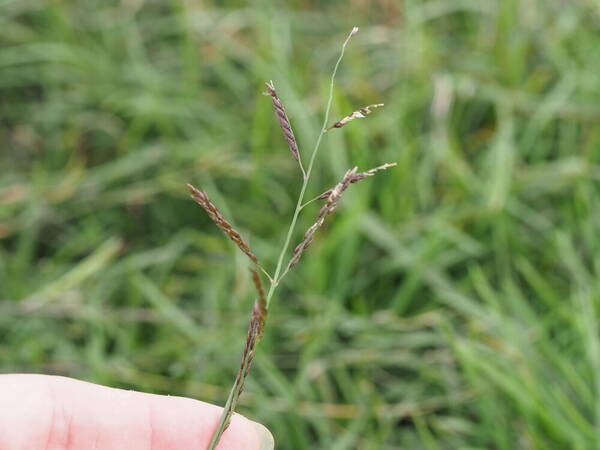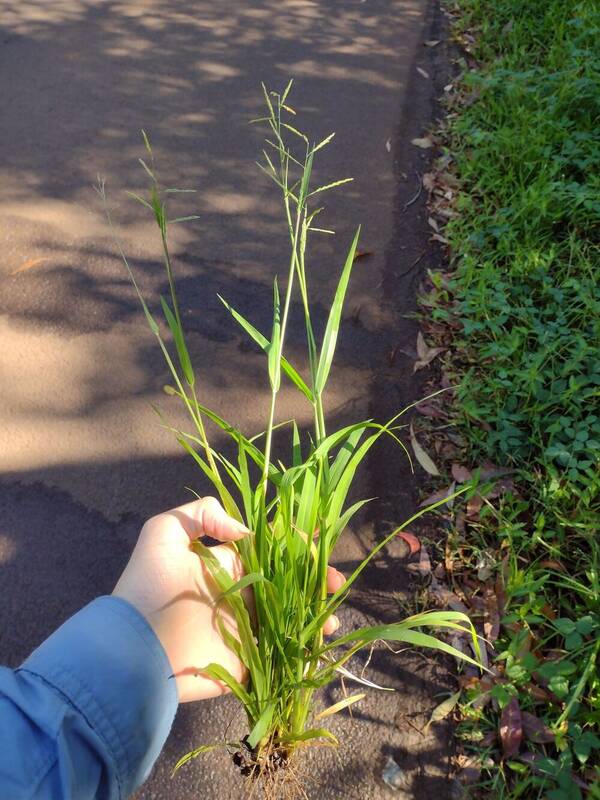Info
Subfamily: Panicoideae
Genus etymology: Eriochloa = "wooly grass" [Greek] refering to the pubescence on the pedicels and glumes
Species etymology: procera = "very tall" [Latin] presumeably refering to the size of the plant, but it is not especially tall compared to other members of the genus
Photosynthetic type: C4 (warm season)
Nativity: naturalized - accidental
First recorded in Hawaiʻi: 1925
Map

Inflorescence




Plant


Habit

Spikelets









Description
Annual; culms 20–100 cm. high, erect or geniculately ascending. Leaf-blades 2–30 cm. long, 2–4 mm. wide. Inflorescence 4–20 cm. long; racemes 2–10 cm. long, the rhachis puberulous, triquetrous, bearing paired spikelets; pedicels commonly glabrous, those of a pair often fused below. Spikelets lanceolate, (2.5–)3–4 mm. long, thinly pubescent; lower glume absent; upper glume acute to acuminate; lower floret represented only by a lemma; upper lemma with a mucro 0.3–0.5 mm. long.
(Description source: Clayton, W.D. & Renvoize, S.A. 1982. Flora of Tropical East Africa. Gramineae (Part 3). A.A. Balkema, Rotterdam. 448 pp. )
Habit: Annual. Culms erect, or geniculately ascending; 20-100 cm long. Ligule a fringe of hairs. Leaf-blades 2-30 cm long; 2-4 mm wide. Inflorescences: Inflorescence composed of racemes. Racemes 3-10; borne along a central axis; unilateral; 2-10 cm long. Central inflorescence axis 4-20 cm long. Rhachis angular; puberulous on surface. Spikelet packing regular; 2 -rowed. Spikelets in pairs. Fertile spikelets pedicelled. Pedicels free, or fused to each other; united below; oblong; glabrous. Spikelets: Spikelets comprising 1 basal sterile florets; 1 fertile florets; without rhachilla extension. Spikelets lanceolate; dorsally compressed; cuspidate, or acuminate; (2.5-)3-4 mm long; falling entire. Spikelet callus globular; incorporating lowest rhachilla internode with adnate lower glume; glabrous. Fertile Spikelets: Spikelets comprising 1 basal sterile florets; 1 fertile florets; without rhachilla extension. Spikelets lanceolate; dorsally compressed; cuspidate, or acuminate; (2.5-)3-4 mm long; falling entire. Spikelet callus globular; incorporating lowest rhachilla internode with adnate lower glume; glabrous. Glumes: Glumes one the lower absent or obscure; exceeding apex of florets; thinner than fertile lemma. Upper glume elliptic; 1 length of spikelet; membranous; without keels; 5 -veined. Upper glume surface pubescent. Upper glume apex acute, or acuminate; muticous. Florets: Basal sterile florets barren; without significant palea. Lemma of lower sterile floret similar to upper glume; elliptic; 0.9 length of spikelet; 5 -veined; pubescent; acute, or acuminate; muticous. Fertile lemma elliptic; 2 mm long; indurate; without keel. Lemma surface granulose. Lemma margins involute. Lemma apex obtuse; mucronate. Principal lemma awn 0.3-0.5 mm long overall. Palea involute; indurate. Distribution: Africa: northeast tropical, east tropical, southern tropical, middle Atlantic ocean, and western Indian ocean. Asia-temperate: China and eastern Asia. Asia-tropical: India, Indo-China, Malesia, and Papuasia. Australasia: Australia. Pacific: southwestern, northwestern, and north-central. South America: northern South America and western South America.
(Description source: Clayton, W.D., Vorontsova, M.S., Harman, K.T. and Williamson, H. (2006 onwards). GrassBase - The Online World Grass Flora. Available at https://powo.science.kew.org )
Cespitose annuals; culms numerous, erect, 5-15 dm tall, branching somewhat above base, glabrous to slightly puberulent, nodes puberulent. Sheaths open, glabrous to puberulent, loosely clasping the stem, especially near base, margins overlapping, ciliate; ligule ca. 1 mm long, ciliate; blades flat, 25-40 cm long, 3-12 mm wide, smooth, sparsely pubescent, margins scabrous. Inflorescences paniculate, composed of 6-8 racemes, the racemes alternate on the axis, appressed to ascending, 2.5-6 cm long, rachis flattened, ca. 0.5 mm wide, puberulent, winged, pedicels long-pilose at apex with hairs 2-3 mm long; spikelets 1-2 per rachis, ovoid, 4-5 mm long; glumes unequal, first glume purple to green, reduced, 0.3-0.4 mm long, forming a small bead-like cuff surrounding base of the spikelet above the point of disarticulation, second glume chartaceous, ovate, 4-5 mm long, long-pilose, 5-nerved, apex acuminate to aristate; first lemma ovate, 3-4 mm long, long-pilose, 5-nerved, apex acuminate; second lemma indurate, elliptic, slightly dorsally compressed, 2-2.5 mm long, glabrous, rugulose, margins clasping palea, apex mucronate; palea elliptic, ca. 2 mm long, similar in texture to the lemma, margins inrolled, apex rounded. Caryopsis ellipsoid, dorsally compressed, 1.5-5 mm long. [2n = 36.]
(Description source: O’Connor, P.J. 1990. Poaceae, pp. 1481–1604. In: Wagner W.L., Herbst D.R. & Sohmer S.H. (eds.)., Manual of the flowering plant of Hawaiʻi. Vol. 2. University of Hawaii Press & Bishop Museum Press, Honolulu )